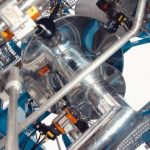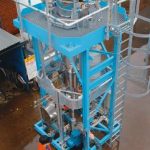In plants with a large exhaust air volume, cryogenic methods for condensing and separating volatile organic compounds with the aid of liquid nitrogen are already proven. CryoCondap ExStream makes this technology also attractive for plants with low exhaust gas flows and particularly problematic VOC. Among the benefits of the method are its environmental friendliness, efficiency and cost-effectiveness.
In recent years, new legislation and a new consciousness of environmental protection have resulted in lower ceilings for the emission of volatile organic compounds (VOC). At the beginning of 1999, the European Parliament passed the directive “on the limitation of emissions of volatile organic compounds” (EU-VOC-DIR for short), which was implemented in German law in August 2001 as the 31st regulation for the execution of the Federal Emission Protection Law. This new legal situation puts an increasing pressure on the industry. By October 2007, almost all old plants have to be adapted to the new ceilings.
Advantages and limitations of cryogenic methods
VOC can be removed from exhaust gas flows in an extremely environmentally friendly manner by way of condensation with the aid of liquid nitrogen. In terms of cost and effectivity, too, cryogenic condensation is superior to thermal oxidation or activated carbon adsorption. Thanks to the use of liquid nitrogen at a temperature of -196 °C, it is capable of reducing the VOC concentration to less than 1 ppmv. In practice, however, emissions ceilings are frequently exceeded when conventional cryogenic condensation systems are employed. Usually this is due to droplets of condensed VOC or to VOC ice crys-tals, which accumulate in the condenser during the freezing process and are carried off by the gas stream because of their low density. When the gas warms up again, the ice crystals melt and re-contaminate the gas that has just been purified. Even if these contaminations remain within the limits, the formation of ice crystals on the pipes impacts the effectiveness of the condenser. For this reason, conventional cryogenic condensation systems are equipped with two condensers, which are used alternately. If one condenser is ready for operation, the other one is switched off so that the frozen VOC can melt. Moreover, VOC vapour can re-enter the process gas flow during this phase through the inlet openings, thus leading to increased VOC concentrations in the incoming gas. In order to counteract entrainment during the passage through the condensers, most cryogenic condensation systems for low VOC output concentrations contain a secondary separation system such as a mist eliminator, which separates VOC ice crystals and liquid droplets from the gas flow. The complete unit thus consists of two condensers and the valves and timers that are required for cycle control of the condensers and of the mist eliminator. In addition, cryogenic condensers require careful, application-specific design, which increases costs even further. In the case of small plants with a volume flow of up to 300 Nm3/h, this is often too expensive.
CryoCondap ExStream
This gap is effectively filled by CryoCondap ExStream. Here, liquid nitrogen is sprayed into the exhaust gas, which is then cooled until the solvents contained in the gas freeze. Filters made of stainless steel separate the frozen VOC in the same working step. The purified gas is discharged at the top of the vessel. The adhering VOC ice crystals are subsequently removed from the filter inserts by a nitrogen recoil and drop down to the bottom of the vessel. There, they are made to melt by an electric heating element, and the liquid organic compounds obtained in this way are then discharged into a tank for recovered solvents. The purification cycle can be controlled either by measuring the counter-pressure on the filter elements or by means of a timer. The filters are cleaned together or separately to maintain a continuous flow. In a typical installation, each filter element is cleaned every five minutes.
Possible applications
In contrast to small adsorption systems, where recycling of the activated carbon filters usually has to be left to external suppliers, CryoCondap ExStream is a closed system. It can be used alone or as a secondary VOC separation phase downstream of a conventional cryogenic condensation system or another separation system. The latter is recommended, for example, when a plant needs to be upgraded because it no longer complies with applicable environmental regulations.
As CryoCondap ExStream does not rely on a fixed condenser area, it is extremely flexible with regard to throughput and operating temperatures. The system can cope with higher throughputs of contaminated gas and with more difficult VOC with lower freezing temperatures by enhancing the volume flow of liquid nitrogen. In field trials, it could be demonstrated that CryoCondap ExStream is capable of effective VOC separation even if the type and concentration of the VOC are not known. The system also works with problematic VOC such as benzole, xylene and acetonitrile. These substances have a very high vapour pressure in the solid state, so that they pass directly from the solid into the vaporous state. When a condenser is switched off for warming up, they do not melt, but form large amounts of vapour which contaminate the incoming gas flow. In the CryoCondap ExStream system, frozen VOC are therefore removed on the bottom of the filter housing by means of a rotary valve.
First CryoCondap ExStream system installed in Germany
The first German company to apply the CryoCondap ExStream technology is Chlorverbund LII in the Frankfurt-Höchst industry park. LII uses the system for removing difficult solvents such as di-chloromethane, trichloromethane and tetrachloromethane from waste gas flows. The order comprises installation of the system and supply of 1300 tons of nitrogen per year.
In existence since 1998, Chlorverbund LII Europe produces base chemicals for various applications. Chlorine, caustic soda solution, hydrochloric acid, methane chlorination products, hydrogen and calcium chloride serve, among other things, as building blocks for drugs, cosmetics, plastics, surface coatings or solar cells. With the aid of the CryoCondap ExStream system, LII intends to recover the VOC released in the production process.
cpp 429
Cryogenic condensation: A cost-effective technology for controlling VOC emissions
More informations concerning Cryo-Condap ExStream
Share:








